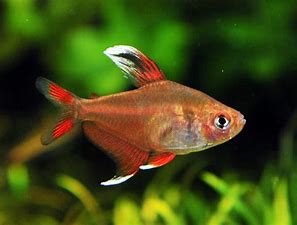White Fin Ornate Tetra comes from slow-moving creeks that branch off of the Amazon River of South America. The tributaries of the Amazon River are usually densely vegetated. These fish are found in areas shaded by the forest canopy where they feed mainly on small invertebrates.
Its colouration and appearance are very similar to its close relative, the Rosy Tetra, with the differences being quite subtle. Both fish have a pink-to-deep-salmon body colour, though the White Fin Ornate Tetra will often appear more transparent. Both species also have dark red markings on their fins. The White Fin Ornate Tetra has a faint grayish ‘shoulder patch,’ which is absent on the Rosy Tetra.
These two tetras can usually be told apart by subtle differences in their fin colouration. The White Fin Ornate Tetra has white markings on its dorsal and pelvic fin extensions, thus the term ‘white ‘tip.’ The Rosy Tetra has a black marking or ‘flag’ on its dorsal fin extension and will sometimes (but not always) have white-tipped fins. Of course, an occasional Ornate Tetra will have the black ‘flag’ type marking on its dorsal fin as well.
Since they are omnivorous the White Fin Ornate Tetra should be given a nicely varied diet. They have fairly high vitamin requirements, so quality flake foods should make up about 60-80% of their diet. They love to chase after live foods and may occasionally nibble on plants or algae. These tetras like several feedings a day, but offer only what they can consume in 3 minutes or less at each feeding.
The aquarium should be heavily planted around the sides and back and have plenty of open water for swimming in the front. It is best to use a river sand for the substrate. Woodwork and floating plants will also help them feel comfortable.
- Species – Hyphessobrycon bentosi
- Common Name – White Fin Ornate Tetra
- Origin – South America
- Diet – Omnivore
- PH Range – 6.6 – 7.8
- Temperature – Tropical 24-28°c
- Breed Type – egg layer
- Current Size – approximately 4cm (Grows to approximately 5cm)
- Sex – Un-sexed


